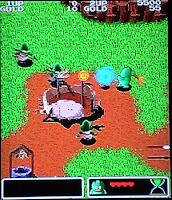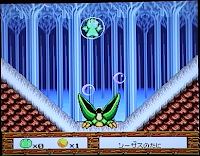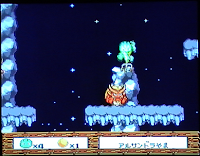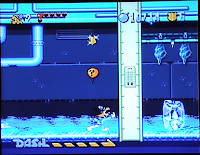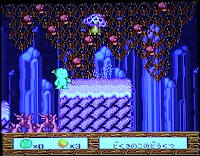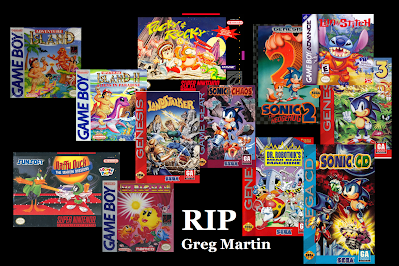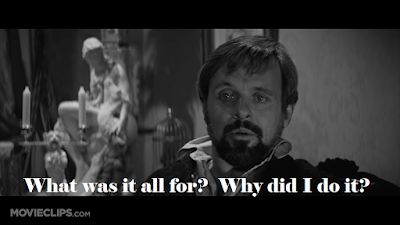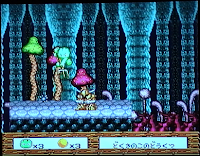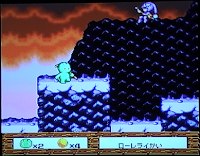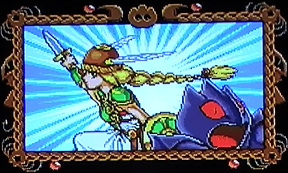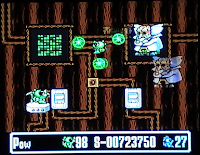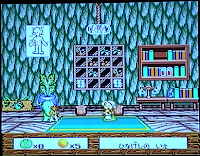💗 Received: March 8th, 2014 💗
💗 Written: February 24th-March 31st, 2022 💗
Alternate Title: Whirlo [ ◯ ]
Year: 1992 | Developed by Nova Games
Published by: Namco | [ ⬤ ]
Disclaimer: I bring forth many .gifs, might contain spoilers
Hello, readers and gamers, welcome to my blog and thank you for taking the time to tune in today, I really appreciate it. 1986 was a big year for iconic female protagonists in the video game medium at a time that it mostly starred boys and men:
the space bounty hunter Samus Aran made a big impression in Nintendo's 8-bit oriented Metroid which had an atmospheric environment heavily influenced by Ridley Scott's sci-fi horror classic Alien, then Taito crafted the Feudal Japan-themed arcade game KiKi KaiKai which starred a Shinto shrine maiden named Sayo-chan who had to use her scrolls and wand to defeat spirits and monsters from Japanese mythology (which would receive sequels developed by Natsume and Altron and get localized as Pocky & Rocky, with "Pocky" being adopted as the Western name for the Shinto priestess), and finally blue-haired high schooler Yūko Asō would get thrust into taking the role of the Phantasm Soldier carrying the Sword of Valis in Dreamland's dire time of need in Wolf Team's Mugen Senshi Valis published by Telenet Japan.
Each of them would go on to become franchises in their own right (some lasting longer than others), but there was one other iconic video game heroine that year.
After the release of Nintendo's Zelda no Densetsu: The Hyrule Fantasy/The Legend of Zelda it became a huge success and would end up serving as one of the major templates for the action-adventure genre of the time. Following their Famiconversions of classic arcade games Puck-Man/Pac-Man and Xevious Namco would create games specifically made for the console (seeing the Famicom as the next evolution in video games), and one of them was the virtually dialogue-free Valkyrie no Bōken: Toki no Kagi Densetsu which drew elements from Norse mythology and was one of the first video games to be worked on by college graduate character designer Hiroshi Fujii, where you took control of a female warrior named Valkyrie who had to travel through Marvel Land and battle a variety of creatures under the evil influence of the dark wizard Zouna.
Valkyrie would end up gathering items that helped along the way such as keys, potions, lamps, sailboats, and secondary weapons, as well as learn magic, et al, sometimes dropped by enemies she defeated while others are inside chests or out in the open, this was also one of the first video games to incorporate a password system in order to resume your progress so you wouldn't have to go at it in one go (sadly it's of the long and complicated variety). At the Enen Desert she would be combating amphibian-like creatures called Xandras (or Sandras) left and right, including one named Krino (or Kurino) whom Valkyrie liberates from Zouna's curse and helps her out in return for her kindness. Valkyrie no Bōken only ever saw a release in Japan that August of 1986 but would be subsequently rereleased over the years (on Nintendo's downloadable eShops) including the 1998 PlayStation One compilation Namco Anthology 2 alongside its remake and would be remade again for Japanese mobile phones in 2006.
This arcade flyer art would be used as the interior art for the NTSC US copy of Tose's Namco Museum Volume 5
Less than three years after Valkyrie no Bōken came out a sequel was created exclusively for arcades with Valkyrie no Densetsu in 1989, created by Namco's character artist Hiroshi Fujii under the pseudonym "Koakuman" ("Quarkman")Namco originally had plans to make this a four-player affair much in the vein of Atari Games' Gauntlet with a cabinet-linking system similar to Namco's own Final Lap, but got scrapped in favor of an experience that could be played up to two players
with Valkryie making a comeback (player one) this time accompanied by the amphibian-like Krino Xandra (for the first time in the series appearing as a playable character, albeit as player two) whom she freed from Zouna's curse as they're on a mission to retrieve the Golden Seed which is said to grant the wishes of anyone who drops it in the Northern Spring and prevent it from falling into the hands of the warlord Kamooz (or Kamuze) who plans to use it for his destructive end.Viewed from a bird's eye view, much like its predecessor was, this sequel had a comparatively straightforward action flavor to it as you combatted swarms of enemies, occasionally helped out NPCs, learned new magic attack spells, and gained helpful items along the way all while maintaining a level of fun and challenge to the proceedings. Characters introduced in the first game (and this one) were given more depth and personality (a choice inspired by Victor Fleming's The Wizard of Oz) to make them "colorful", Valkyrie was made to be strong-willed and uncompromising with a strong sense of justice,
Marvel Land had a sense of "magic" in-between with its locales being inspired by ancient Europe and the Middle Ages, and it had a gradual increase in difficulty along the way (which is keenly felt near the end). Another success story from Namco, Valkyrie no Densetsu would see a reportedly downsized home conversion on the NEC PC Engine in 1990, and for the first (and only*) time it would see a localized release outside of Japan
* 4/13/2022 Update: Back when I wrote this review that was the case anyway, for HAMSTER is releasing it under their Arcade Archives catalogue on the Nintendo Switch on April 14th, 2022
I'm genuinely reminded of Zoom's Lagoon in regards to some of its occasionally darker contrasted colorization and visuals (be it background or character), which is strange since neither game share the same graphic artists (let alone had the same people involved)
as one of five games included in Tose's 1997 PlayStation One compilation Namco Museum Volume 5 with an official English translation retitled as "The Legend of Valkyrie", which might partially attribute to that collection's high price tag as it is highly sought after among retro video game fans and enthusiasts (especially those of the obscure variety).But what circumstances led up to the fateful encounter between Valkryie and Krino Xandra? What was Krino's story and how did it tie into the events of the first game?
Image from GameFAQs; I love the little detail of Krino sticking out his head to make up the ン ("N") kanji symbol in the title, that is such an adorably clever touch
Those questions would serve as the basis behind the making of Xandra no Daibōken: Valkyrie to no Deai (or Sandra no Daibouken: Walküre to no Deai*, which translates to "Sandra's Great Adventure: Encounter with Valkyrie") which was released for the Super Famicom in Japan on July 23rd, 1992. Programmed by Carrot Ogawann** and Shin, map edited by Matu, with "puppet operation" by Ogawann and Moon Side (who also worked on the "enemy operation" but with Shin), and written by Hiroshi Fujii under his "Ippadeitayo Koakuman" pseudonym and someone by the name of "Mars 89-92", this game would be published by Namco and developed by Nova Games.* I bring these alternate English spellings of Japanese names up to show there is no right or wrong way to spell them in English, I simply choose to address them this way
** Hence the carrot selection icon in the title screen as there are no such vegetables anywhere in the game proper 🥕 Fun food for thought fact!
Nova Games was a Japanese company who had their hands in developing notable video game properties during the '90s such as the MegaDrive/Genesis version of Namco's Burning Force and the Game Boy version of Tomcat System's Battle City (a Namco IP), the horseracing Super Famigame Battle Jockey (published by Virgin Interactive), the Super Famiconversions of the first two iterations of SNK's tournament fighting Garō Densetsu/Fatal Fury franchise (both released by Takara),
In hindsight, it should've been obvious that both it and today's game shared the same developer as they do share a somewhat similar sense of visual aesthetic... anyway, cute little sea lion, d'awwwww! 🤗
the Takara-published Super Famicom adaptation of Hiromi Morishita's seinen manga and anime series Shōnen Ashibe with Goma-chan no Yūenchi Daibōken, and Battle Dodge Ball II (released by Banpresto), to name some examples.Marvel Land was in a state of tranquility and peace, right down to the Xandra Clan's home in Sandland Village, unfortunately it would be short-lived as the volcano at Mount Alsandra beside it suddenly erupted causing a violent earthquake and for the land to slide and sink beneath the earth. Chaos ensued.
[To the tune of Richard Wagner's "Ride of the Valkyries"]
🎵 Zouna is eee-vil, Zouna is eee-vil, Zouna is eee-vil, ye-ess he iiiiis 🎵
Zouna, a dark wizard, relishes his newfound freedom after being sealed for so long and plans to use his powers to rule over Marvel Land as well as punish those who attempt to oppose his might. Sandland and its inhabitants were the first to feel the wrath of Zouna's magic as he conjured up a plague via his Ashes of Despair which turned the land into a drab gray, withered their crops, polluted its waters, and turned any unfortunate soul who was outside to stone. Worse, Krino Xandra's infant child too was stricken by the deathly plague, becoming weaker and weaker by the minute. Not wanting to stand idly by and do nothing, Krino ventures outside of Sandland (while his wife is taking care of their child) and goes to see the Elder for he might know the solution to this dilemma.
Once arrived at the Elder Xandra's tree house Krino tells him about his son being sick as well as his fellow Xandras and consults with him about what to do. The Elder tells Krino about the Sun Cure and how this legendary elixir is said to cure any ailment, but in order to acquire it he'll need to gather seven light crystals (individual fragments of a star that fell long ago) and hold them up to the sky. Willing to go above and beyond regardless of the dangers ahead of him, Krino will stop at nothing to find the Sun Cure and secure his infant son's future; fortunately, the Elder just so happens to have the first light crystal inside his giant knapsack and gives it to him for his quest. Now only six remain to collect.
Left: Defend the territory from incoming Tatta attacks | Right: Some more Tattas to dispose of along the way
In the sidescrolling action platformer Xandra no Daibōken: Valkyrie to no Deai you take control of the amphibian-like humanoid Krino Xandra of the Xandra Clan who's got a variety of abilities at his disposal. He can run left and right, climb a rope up and down, enter a doorway by pressing up in front of it, do a normal jump with the B button which has a limited altitude, do a leap jump by lightly pressing the A button as he runs, perform a high jump by holding down the A button for a half second if not a full one or more and then letting go to have him gain a higher vantage point in the air (but do not hold the button any longer than you need to lest you wish to tire Krino out),Left: Skipping across a gap in front of a haunting figure | Right: Spinning around in the air wielding a pitchfork against that propelling pincer... crab... thing
and by holding down the X buton Krino will vertically position himself high up in the air to wind up a Whirlowind Attack which so long as you keep the button pushed down you'll slowly lower yourself to the ground whilst winding the punch; by letting go of the X button at the precise spot you're at in midair, be it an enemy target or narrow space, you'll propel yourself across like a whirlwind up to a point. The secret to gaining a higher jump than normal when it comes to the last two jump types is to go the opposite direction for a half a second only to immediately turn back to the direction you're aiming to go while simultaneously holding down the A or X button and letting go at the opportune time.Left: "OW!!! It's annoying enough being stepped on by that stupid treasure hunter [Pitfall Harry], this is taking it a step too far!" 😡 | Right: Poof
Armed with pitchfork in hand you attack your enemies with it by pressing the Y button, either while standing normally facing an enemy in front of you or while holding onto a rope, in midair which makes Krino spin around so long as you hold down the button, and strike it downward while also in midair as you hold both Y and the down arrow together; should you have the pitchfork face down as you touch the ground Krino will try to get himself unstuck (how long it takes for him to do so depends on how high he fell down from).Left: Hard bouncy fall | Right: Poof squared
There are three different potency levels to using Krino's pitchfork: there's the normal lunge on the ground and on the rope takes more hits to defeat an enemy or boss (naturally), the downward strike is roughly double the damage of the normal pitchfork attack (which is helpful to know during certain spots), but the most powerful pitchfork attack comes from the Whirlowind Attack as it deals a huge amount against your foes (in some cases it's mandatory provided you timed it right).Left: Talking with the Elder Xandra | Right: Incoming boulders
Should an enemy or its projectile come into contact with you, fall offscreen, or land on spikes, you will lose a life as in this game you die in one hit; each stage is divided into segments, so should you lose a life you'll be brought back to the beginning of a segment, its midway point if said segment is long, or at the start of a boss battle. Any time you begin the game or resume from your last progress via password you'll start with seven lives (none of which can be regained once lost), which is perfectly reasonable, and once you've reached the end of a stage (or lost all your lives) you'll be given a sixteen-symbol password to pick up where you left off; certain stages will bookend themselves in a boss battle.Left: Plopped halfway through the ground after a long fall | Right: To think the Shezas (or Scissors) act as enemies in the other games bearing the Valkryie moniker, guess this one is going to spare Krino for granting it nourishment
Xandra no Daibōken has got a very visually appealing aesthetic in terms of its color palette, soft touch plus delicate strokes, and sense of detail; the graphics were worked on by Nabe, Q, Kanebow, and Maru Su (Choppiri Su) with art concept/character designs by Yarinage and animations provided by Ben the Great as they were credited under their pseudonyms (I know not what their real names are). Marvel Land has a good variety of locations designed with a sense of endearment that Krino ventures through, and on occasion your eyes are treated to areas that are very beautiful and striking to look at, for they all have their individual sense of atmosphere.
Left: Meeting the wandering merchant Zuhl | Right: Fighting against the Quarkman matriarch Andy
When you start the game at Sandland you see its houses shrouded with ashes with its crops withered as the Ashes of Despair slowly and gradually fall from the sky (it almost resembles snow) for you can see the rest of the village loom in the distance (especially after having visited the Elder Xandra) underneath a darkened sky, on the way to the Elder you go through a waterway in the forest that looks so haunting and breathtaking with the specters pouring stars down the body of water and occasionally see constellation of horses sauntering in the backdrop, on the way to the Quarkman's villagethere is a subtle change of the sky as it slowly turns from blue to orange as it goes along due to the rampant runaway flames as you also contend with devious trees who've got branches on top of them creepily resembling a hand, the inside of the cave residing at Mount Alsandra is lightheartedly ominous with its infernal shades of red and creepy rock-formed faces, Toadstool Cave is all luminescent inside its purple and turquoise corridors adorned with eerily laid out mushrooms and fungi,
Left: Yeah, teamwork! | Right: Destroy the rock head so it doesn't spew out flames anymore
Tree Island is atmospheric in that there are many trees surrounding the location with plenty looming in the backdrop to give it some atmospheric depth, there's a solid series of parallax scrolling clouds upon moving around in Neverland, and the last stage is colorfully and imaginatively varied in terms of theme and design; my all-time favorite segment of the game is when Krino undergoes the Test of Courage set in a star-studded backdrop where his family and friends' faces brighten and darken here and there in the form of constellations whilst there are shooting stars, it's one of those many elements that make the experience endearing and all its proceedings worth it.Left: Coincidental timing with that sentient flame locking in on Krino's position while the pillar of fire is temporarily risen up 🔥 Flambé! | Right: Taking care of that horned devil from above
The characters and enemies are designed in a solid and charming manner, and their sense of animation is limited but effectively paced that it works just right. Krino Xandra is adorably designed as he's wide eyed and expressive depending on whether he's attacking enemies with his pitchfork or winds up his Whirlowind Attack (with a determined glare), clenches his teeth as he's trying to get his pitchfork unstuck from the ground, gets happy when he hears good news, spins his eyes around momentarily after becoming dizzy from flying against a wall or pulling off a Whirlowind Attack towards thin air, at certain points later on he has a shocked and a concerned expression (in that order one time), and I like the way he nods his head during certain conversations and the way he holds the light crystal aloft once he procures it.
Left: Krino must knock the Crescent Moon King out of the platform with as many Whirlowind Attacks as needed in order to gain another light crystal and rescue... | Right: BABY SABINE, AWWW!!!! She's so tiny!
Whenever Krino uses his pitchfork in midair he spins around so swiftly, and I like the little dust effect that appears when he skids as you make him turn a direction after running and whenever he makes a leap jump (good sense of detail). He's even got different animations for when you lose a life depending on how it happened; most are lightheartedly comedic (like when his body instantly gets singed from his feet up to his head with a shocked incredulous reaction when come into contact by fire) but there are a couple in particular that I find a bit disturbing (when he appears lifeless upon drowning in water and when he gets electrocuted by a Robotian's laser you can see his skeleton as it flashes black and yellow).
Left: Finding myself at a flooded Caldera | Right: Meeting Grady the toolman and Peppy
Among the enemies Krino contends with are the cavemen-like Tattas, the toros, the bouncing Quarkmen (before Andy agrees to help you), the horned devils, vultures, square-shaped Robotians, green and tan-colored winged imps, pirates, and sand creatures, et al, and the bosses you fight such as the salamander and Zouna are all big and imposing in size and design.In-between stages are very well drawn cutscenes (a few of which have got limited animation) that do a good job of telling the story visually, all having that Hiroshi Fujii touch viewed inside an endearingly designed frame.
Left: Oh no, not the Gatekeeper! 😧 Hope the Keymaster is not around... | Right: Introducing the knife-juggling pretty boy Buck
Responsible for Xandra no Daibōken's sound unit was Norihiko Togashi, Nakanobu Tarō (real name Nobutake Nakamura), and Hiroshi Ebihara; Togashi in particular (credited under his "Noririn" pseudonym) is notable for he's got several video audio credits under his belt (largely for Nova Games-developed and/or Namco-published fare) such as N.H. System's NEC PC Engine conversion of Namco's Märchen Maze and the Sega 16-bit port of Namco's Burning Force, Nova Games' Nintendo 16-bit version of Bandai Entertainment Company's Ultraman,the Namco-published Super Famiplatformer and puzzler Super Wagyan Land (also developed by Nova Games), Nova Games' contribution to Capcom's long-running iconic Blue Bomber franchise with RockMan's Soccer/Mega Man Soccer, and sadly went uncredited (like much of the staff) for his audio work on Capcom's Nintendo 16-bit take on Bonkers/Disney's Bonkers: Hollywood Daisakusen! based on the Disney animated series, meanwhile Ebihara had also worked on the sound department for Nova Games' Nintendo 16-bit ports of SNK's first two Garō Densetsu/Fatal Fury games.
Left: I love how Krino is floating on the body of water formed up by Princess Tiana's near endless amount of tears, though I'd rather have that than see him drown | Right: Run away from the water!
Xandra no Daibōken's soundtrack is absolutely captivating from the start, it's fantastic across the board, grips you from the word "go", it does an impeccable job at capturing the proper tone and emotion of the situation and succinctly complements the atmosphere for each place you go through. Despite the simple usage of notes the lightheartedly sad tone of the cutscene theme brings a sense of immediacy and importance to the story, whenever you meet up with a (new) friend there is an endearingly composed theme that has got so much heart and warmth that evokes a strong feeling of empathy, when journeying through the forest (and when treading on an icy path) there is a beautifully haunting melody that's perfectly fitting while simultaneously giving off a sense of atmospheric wonder,Left: Krino meeting a cute little family after narrowly escaping Caldera Castle's flooded basement | Right: (SHHHH, Sabine that mysterious Quarkman is sleeping!) 🤫
the music that plays in the depths of Mount Alsandra and at the Enen Desert sounds impending and relentlessly foreboding, Caldera Castle's theme is lightheartedly elegant while the Nick Clan theme sounds enjoyably playful (which is apropos as their segment is riddle-based), Toadstool Cave's theme is intimidatingly ominous-sounding throughout, Tree Island's theme sounds wholesomely atmospheric and on occasion quite bouncy, if you choose to have Krino help Nubs learn how to play the viola you're greeted to a very relaxing melody that is soothing for the soul, the boss theme is ceaselessly hectic, and Zouna's theme (heard whenever you lose all your lives, after you defeated him at the end, or during any bad ending scenario) has a pessimistic air about it to the point that it saps out all hope.Left: Buck upping the ante to his knife juggle act by going at it blindfolded | Right: Standing at the foot of Toadstool Cave
"Sunny Skies" is the standout theme of them all as it's played throughout the majority of the game (including during the ending credits, which I'm very grateful for), and my favorite in the entire soundtrack, it's sort of similar to the main theme you hear in Valkyrie no Densetsu only here it's more inspiring and hopeful to listen to, the fast-tempo orchestration is on-point (the swells... 😭), and it fits Krino to a T; in fact, this theme is like a character in of itself, it gets me pumped every time I hear it (I could listen to it for such a long time and never get tired of it, it's that good), not to mention it is so empowering! I love this theme SO MUCH, it's *chef's kiss*! 😙🎔Left: What's worse than pollen? Sprinkling spores that will absolutely shock you to the touch, that's what! | Right: Jabbing that dopey-eyed tan-colored imp
The Legendary Tower has got an epic powerhouse theme which is equal parts emotional and empowering as Krino nears the end of his journey's aim and is a perfect theme to hear while undergoing its three tests, and finally before the credits kick in you hear an incredibly rewarding and breathtaking take on Valkyrie's theme (first heard almost six years prior in Valkyrie no Bōken) and is such a wonderful way to bookend the story of Krino's first venture as the two finally meet, and its top-notch sound quality makes it impactful to absorb once its concluded. The sound effects are lightheartedly cartoony, I like the sound of the impact made by the pitchfork, the sound when Krino revs up his high jump and Whirlowind Attack, the timpani drum (I think?) sound for when Krino makes a hard landing and bounces up into the air as a result, and when a boss lets out an echoic grunt upon being defeated it sounds super satisfying.Image from GameFAQs
At an unspecified date in 1992 gamers who owned a Super Nintendo console in Europe and Australia got to play the localized version of Xandra no Daibōken but as Whirlo (with it being adopted as the main character's name likely in reference to his Whirlowind Attack) albeit in very limited quantity, and... I have a sincere apology to make. 😔 Responsible for the PAL cover art was Gregory James Martin ("Greg Martin" for short) who was an American freelance illustrator and artist for Disney and Hanna-Barbera properties during his start,but would become more popular as the cover artist for the North American versions for a lot of iconic video games released during the '90s, especially Sega's Sonic the Hedgehog franchise for the first half of the decade,
One of the reasons I wanted to cover this game again was because in January while I was at work I thought of Whirlo's cover art and in the back of my mind I subconsciously made a connection to Super Adventure Island's cover art before verifying for myself to see if both shared the same artist through Google, and they did (not going to lie, I'm a little wigged out that I managed put two and two together on my own 😲); it's the expressiveness, purposefully animated nature, and delicate brush strokes that tipped me off, also the eyes 👀
the American cover for Produce's sole contribution to Hudson Soft's Takahashi Meijin/Adventure Island franchise supervised by Westone with Takahashi Meijin no Daibōken Jima/Super Adventure Island and the cover for the Iguana Entertainment/Iguana UK co-developed sequel to Sunsoft's former American mascot Aero the Acro-Bat 2; he sadly passed away on May 21st, 2013 at the age of 56 but wasn't made publicly known until the start of 2014. When I first saw Whirlo's cover, however (post-giving this game another chance in January 2016, and ending up learning to love it the further I went along) my initial reaction was... not all that positive, and the reason why was because I had grown very fond of Krino Xandra as a character and his selfless resolve, so for me to see his European counterpart Whirlo cradling gold in his arm and appearing to look at it intently (almost with a sense of avarice) didn't particularly sit well with me given his sense of altruism and felt very out of character.Even if he was in it for the riches, no amount of gold--no matter how generous--is going to help anyone out of a plague
But years have passed, I'm turning 31 on April 5th, I've learned to mellow and accept that this has happened. It's no big deal. Alas, I've brought up my displeasure of Whirlo's cover on a few occasions on my blog (and, I regret to inform, on a couple websites) and one time took it so personally (again, I love the main character) that in hindsight I fear I may have crossed a line. *pauses, breathes in, breathes out* When I Google searched Greg Martin's artwork (not knowing anything about him until these recent months) back in January to see if he shared a connection with both Super Adventure Island's and Whirlo's cover art (he did), I was alarmed to discover that he had since passed away all these years ago. Alarmed because I thought of those times I was harsh on the cover art and portrayal of the main character, not having realized that Martin was no longer among the living; learning of his passing changed everything. I felt like I had needlessly soiled on this artist's legacy in hindsight when I shouldn't have, all those times of feeling like I was improving little by little as a reviewer only to wonder if I was actually getting worse (giving me pause over whether I had improved at all) and this was one of those instances.Screengrabbed while watching MovieClips' The Elephant Man clip, property of Paramount Pictures, on YouTube; that introspective movie line is so iconic
I'm sorry, Greg Martin. 😔 I'm sorry I didn't realize what an impact your art had for those who gamed during the '90s. I'm sorry I expressed my distaste for your Whirlo cover the way I did (more than once) in years past, it was wrong and inexcusable; I'm sorry I went hard on it when I should not have. I'm sorry for not having known that you had died all these years ago, I've felt horrible about it since. I'm sorry for possibly tarnishing your legacy with my harsh words from the past without even realizing. I'm sorry for everything. Some thoughts rushed through my head upon learning of his passing: how could I possibly continue reviewing (knowing what I had done) and how I should've approached it with more empathy (if critiquing gives off the air that one lacks empathy, what is even the point in doing it?)? ... I need to do better, and I'm going to start here. 👇Images of the back of the Japanese box and from the front of the European cover from GamesFAQs, cropped by me; wait, you're giving an affable presence like Krino Xandra in-game angry eyes, Namco of Europe? You're giving... Whirlo... angry eyes? 🤔 I can't help but feel that this decision may have been a bit counterintuitive, even if it's only on a surface level and doesn't reflect his personality one bit (which is kind and giving)
The gameplay, structure, and overall quality is pretty much identical in both versions, the first stage added some extra lines of dialogue teaching you its controls, and certain characters were given name changes: Quarkman was changed to "Cualkman", Zuhl was now known as "Slick", Andy's gender was changed from a mother figure to a father figure, Andy's daughter Sabine was changed to a son named "Steven", and the main villain Zouna became a villainess named "Malix"*. But the most notable change of them all was the main character being given angry eyes as a neutral (albeit purely surface level) expression, which is very baffling that Namco of Europe would go in this direction (especially since the cover art shows him being happy). I'm not as disdainful that this happened like I was in previous years due to my affinity for Krino Xandra as a character, perhaps Namco's PAL division** didn't feel the game would be taken as seriously with a wide-eyed expression (as if the opening wasn't gripping from the get go), but I do find that it showed a lack of cognizance on their part and likely applied this visual change purely out of culture bias.* Malix takes fifteen Whirlowind Attacks in order to defeat in the end whereas Zouna required twenty-four Whirlowind Attacks in all, making for a comparatively easier fight in the PAL version; I know this because I recently got to play the NTSC SNES repro cart of Whirlo
** I have not seen any indication that this game was ever officially slated for an American release, but given that Greg Martin generally designed the cover art for the North American region's version of a game, I'm curious if it may have been a possibility and whether the changes in the PAL version were influenced by Namco's American division
Left: Slowly locking in on the target that is Robotian before releasing the powerful attack | Right: Contending with green-colored imps
Both Xandra no Daibōken and Whirlo were given generally mixed reviews upon release: Famitsu handed it a 24 out of 40 (one point higher than they would give Polestar's Magical Pop'n less than three years later), Joypad gave it a 51%, and GameFan a 249 out of 400 as they didn't feel all that strongly for it, on the other hand you had HobbyConsolas, Super Play, and Superjuegos who were highly receptive to it as they awarded the game an 89 out of 100, 88%, and a 93 out of 100 respectively. It certainly split critics down the middle, but fortunately those among the audience who played it had a higher sense of appreciation for it.Left: Those Dadatta enemies could almost easily come from a Druaga game (also a Namco IP) | Right: Battling that salamander
I first learned of today's game less than fourteen (!) years ago while browsing RVGFanatic's website (hi 👋) back when I stumbled across his website back in 2008 and sometime afterward I looked it up on YouTube and saw a short gameplay video by Gonçalo "ShiryuGL" Lopes (also hi, if you stumble across this review 👋) and I remember what screenshots I saw of it looking interesting back then, but wouldn't get to play it for myself until March of 2014 back in the days when I played Super Famicarts on a RetroDuo*. I struggled my way through the first two stages, taking awhile to learn their layout and enemy patterns, which was all well and good... and then I got to Caldera Castle's waterfall vertical scaling segment for the first time which is when things took a turn.* This was over a year before I asked for a Super Famiconsole for Christmas in 2015, had I known that American and Japanese products shared the same outlet plugs I would've gone for it at the start; I still feel sheepish to this day not having known that initially
It could be because of the wooden material they're made from, but whenever I see these two rising platforms I always think of the wooden puppet Pino from Toy Pop,
Namco's colorful Japan-exclusive fun and obscure 1986 arcade game made available to play in the West for the first (and only) time in Tose's compilation Namco Museum Volume 1 for the PlayStation One during the following decade.
Since September 2021 with Square-Enix's impromptu release of Sonic Powered's Renaissance remake of Quintet's Actraiser/ActRaiser, I've become resigned to the notion that Square-Enix does not care about Quintet unless it involves their well-made but in my opinion aggravatingly overexposed inaugural game; it honestly makes me feel both saddened and disheartened that they continue to give it special treatment (using its popularity as justification for doing so) while this sequel, the Gaia trilogy of games, and Slapstick/Robotrek get nothing?? Nothing post-initial release on a console that is well over three decades old (one not everyone has the luxury to own and afford)? 😞 It's! Not! Fair!
The irony had been lost on me until near the end of my first playthrough six years ago that I ended up thinking of Quintet's ActRaiser 2.One of my biggest fears is dying out of fatigue, hence this particular screenshot; fatigue from wanting to be everywhere and do everything all at once but is physically impossible, fatigue from sometimes feeling like I have to stop doing that one thing to do another (sometimes through my own doing, but mainly help when asked for it) going back and forth sometimes frequently (worrying at times that it gets in the way of getting the one thing I'm doing done), not saying anything out of fear of being perceived as selfish or only caring about myself (I don't), feeling guilt for having these feelings to begin with... it's called being a human 😩 *sigh* Such is adulthood
It might seem weird that I'm comparing these games to each other, but hear me out.Back when I first played ActRaiser 2 all the way back in October 2011 I was drawn to its gameplay, and no matter how hard it got I stuck with it until the end of its three difficulties for I did not give up on it (and I know there are plenty who had); I did not give Xandra no Daibōken the same due back in March 2014 because I was having difficulty with the upscaling waterfall segment and fell prey to the Fox and the Grapes Syndrome because after several attempts and failing that portion I gave up on the game altogether. This game was my ActRaiser 2. After giving up on the waterfall segment, though, I made the grave mistake of prejudging this game's quality as a whole after only having played through over a quarter of it as a middling game that was depressing--that was also wrong of me.
SABINE, NOOOOOOOOOO!!!!! 😫
Xandra no Daibōken is not depressing in the slightest (though if you only got up to a point where you saw its dark intro and worked so hard to reunite Andy with Sabine only for them to get separated again after the Crescent Moon King exacts revenge upon being defeated, you'd probably be hard-pressed to think otherwise), things do get better from there. The sad truth was my initial feelings derived from bad timing: in my last year of college, I remember one of my professors being visibly upset that only four of his pupils (among them, me) were passing his class while the rest weren't and didn't hold back on his disappointment one iota (as 3D modeling was his passion), to the point that he asked the whole class, "Do you want to end up like van Gogh?!"--i.e. unsuccessful in life. I remember feeling shook up, scared and uncertain of my future, it kind of affected my mood a bit, compound that with me seeing the cutscene with Andy and Sabine split up and having no patience for the upward scaling waterfall segment feeling like I failed the game altogether (and Krino's infant child)...a disastrous recipe, if I do say so myself. If I had played this game for the first time literally during any other point in my life (I mean, any other point), I hope that I would have been kinder on it. 😔
Left: Rafting across | Right: It's Sabine that mysterious Quarkman again, this time holding a staff sitting down under an ominous thundering sky
Once I got a Super Famicom console for Christmas on 2015 I promised to myself to give Xandra no Daibōken another chance on January 1st, 2016, sort of like a New Year's resolution, only this time I was going to stick through it 'til the end no matter what; I did not want to repeat the same mistake. After learning to get my timing right and go with the flow (with each step you make on the opposing platforms with a well-executed high jump, the faster they start to operate), I finally managed to surpass what I first thought was impossible which made me happy; not only that, the further I went along (despite the challenge value) the more the game grew on me, I got to appreciate and recognize its many strong qualities, and for that became one of my favorites. I reviewed it back in January 2016 and gave it an 8 out of 10, which I still feel is a fair score (but this time I wanted to articulate myself in a better and levelheaded manner and be up to date with the information as I got a few things wrong), and in the years since I caught up with the Valkyrie-led games in the series Valkyrie no Bōken on a 500 in 1 plug-and-play NES-like system (since one of my mom's friends knew I was into retro gaming) in Christmas of 2018, and Valkyrie no Densetsu I would play on the compilation Namco Museum Volume 5 on January 2020 (the highest I've ever spent ordering a game on eBay to date). And in the years since I've played through Xandra no Daibōken several more times (and caught up with Whirlo via an NTSC SNES repro cart this year... it's okay, they can coexist in the same room together). 😃This password only works for the Japanese version, it is not yet known what the European version's password for this segment is
Shortly after the first time I beat this game in 2016 I learned via a YouTube video (due my obsession with the music track "Sunny Skies") that there was a password that led to the inside of the store in Tree Island that is normally inaccessible during the normal game, immediately placing you there but without any preceding cutscene.Noticeable right off the bat is the light crystal count being down to zero, which certainly makes the whole accessing the Legendary Tower at the Enen Desert a bit problematic 😖
Essentially it is one vast elongated segment devoid of enemies where you start at the top and must venture all the way to the bottom until you exit through the door with the leaf motif on it, but it is not as simple as it sounds though.Due to everything being frozen in place the grounds are a bit slippery, it is replete with frozen icicles above and below certain platforms that will easily cost you a life if you're not careful, it's got lots of inclines that you occasionally must bypass via a Whirlowind Attack, sometimes you'll have to strike the pitchfork downward to ensure you don't accidentally bounce off a platform below you (potentially unto icicles) should you fall down a certain distance, and unlike other prolonged segments where they at least had a midway point after losing a life you must tread lightly and carefully do it in one go otherwise you have to start over again no matter how far you got. Entering the door with the leaf motif will instantly take you to Neverland without any cutscene in-between and wind up skipping the opening conversation with Walter altogehter.
The only proof in-game of this segment's existence is the leaf motif door and frigid indoor environment upon entering Tree Island's store through its window with the store owner trapped inside. I can certainly see why Namco removed it from the game proper, it is a bit overlong and can get a bit steep even for its difficulty plus the prospect of having to undergo it all in one go lest you start over is not exactly an appealing one. The icy store segment is definitely a manageable curiosity if you take the time, but not one you would particularly miss when it's over.
According to The Cutting Room Floor, this password works for both Xandra no Daibōken and Whirlo
And during the past year I learned that there was another special password, this time taking you to its test map.It's always a pleasure to listen to "Sunny Skies" which serves as its background music, absolutely devoid of enemies but has got a varied layout design so as to get acquainted with Krino's multiple jumping controls,
up until you reach the end of the line and cannot progress any further. The Krino title sprite serving as a placeholder for presumedly the start of the map doesn't do anything as far as I'm aware (trying to jab or hit it won't do anything either), and like the frozen store area it is a curiosity to experience if you've got the time. And since there is no way out the only way to exit is through shutting the console off or doing a soft reset to return to the title screen.
Left: That poor defenseless whale needs help getting out of its icy conundrum and back in the water | Right: Free the whale! 🐋
Krino Xandra is such an endearing kindhearted character, so compellingly written in his selflessness and his resolve to save his family and fellow Xandras is inspiring. He doesn't have much experience outside of Sandland and yet he would go far and beyond to find the Sun Cure to lift the curse of those unfortunately afflicted by Zouna's Ashes of Despair, and one could opine that he might be a bit in over his head due his inexperience but he's doing it out of a noble and selflessly bighearted cause. But what makes his story incredible is that it starts off simple but along the way he meets many a character whom he helps out during his journey, and in return they help him, as suddenly the proceedings become larger than life.
I also adore his expressiveness when it comes to the dialogue and when performing his abilities, it adds so much to his character and adds to his already likable personality (I also like the way he tumbles down if he's falling for a long time); a couple moments I like are the last time he runs to Caldera Castle's throne room to talk to Princess Tiana he trips on the way, and when Andy refers to Krino as a warrior he ends up blushing as he never thought of himself that way.
He is like a beacon of hope in these dark times personified as despite his inexperience he helps those along the way in a way that makes a difference, gives good advice to Peppy and Nubs about following their heart and dreams, helps reunite key characters together, and is very resilient in his resolve to find the Sun Cure to save his family;
You just want him to succeed
that's a real hero right there. I don't know what we did to deserve this strongly written character, Hiroshi Fujii, but I am glad he exists the way he does. He's so underrated too, I kinda wish he appeared in more games (nothing against Valkyrie, I just like Krino Xandra more).Screengrabbed while watching SteelSeven Playthroughs' Namco x Capcom and Phosphobos' The Glory of Walküre gameplay footage on YouTube respectively; look at him with that golden armor, he looks positively amazing, MAHVELOUS even! 😆
The last time Krino appeared as a playable character in a video game was Monolith Soft's 2005 large-scaled crossover tactical turn-based RPG Namco x Capcom on the PlayStation 2 (with the young Quarkman Sabine as his companion), and in 2007 Bandai Namco (following Namco's merger with Bandai) created the open-ended sidescrolling action adventure The Glory of Walküre for a tiny segment of the game as he searches for an antidote for Valkyrie after she becomes poisoned following a battle in the desert created exclusively for Japanese mobile phones (and would be released again in 2012 for Android smartphone users). Neither game was released outside Japan.His high likability is the main reason I don't like seeing him succumb to Zouna's dark spell upon losing all his lives and after having defeated him at the end (or so you thought), losing his heart and soul in the process.
I know it's done to bridge the gap between the events of this game and Valkyrie no Bōken as it is an important moment of the Valkyrie franchise, and it does it well, leading up to the fateful encounter with her compassionately breaking the spell and returning Krino back to normal. I guess it's a fair tradeoff, I just wish we didn't have to witness the body horror he had undergone as he got turned evil. 😱
Love that Super Famicameo in the final stage, Nova Games and Namco, nice! 😄👍
I also love how, much like Wagyan before him in Super Wagyan Land, Krino is a father who would do whatever it takes to save his son (albeit from highly different circumstances).There's plenty of elements that set this platformer apart from other titles of its ilk at the time: while hardly the only platformer to do this (others include ASCII's Ardy Lightfoot, Polestar's Magical Pop'n, SAS Sakata's Donald Duck no Mahō no Bōshi, Ukiyotei's Kuri Skunk/Punky Skunk, and HAL Laboratory's Kirby's Dream Land 3/Hoshi no Kābī 3) it is not score-based, which always pleases me as I play platformers not for score but for the fun and enjoyment. Krino's main objective is to gather light crystals, but aside from that there is not a single power-up anywhere for him to utilize (no power enhancements and nothing to temporarily make him invincible); it's partially to do with the one-hit system, but I saw this to be a pretty unique and commendable quality. Krino doesn't need power-ups, he is his own power-up and can pretty much hold his own without one considering it's his first adventure, for his versatile abilities are enough to carry him through his arduous journey.
Left: "I will never join you! Get the point?" 🔱 | Right: Krino bringing an unconscious Fairy (who may or may not make an upcoming cameo appearance in Nova Games' Super Wagyan Land 2) to Tree Island's resident magic doctor
Generally in the platforming genre the number of jumping types is limited to at least one (if not two) with your gained altitude normally dependent on how hard or how lightly you pressed the jump button, but with this game having four jumping controls making up the bulk of the gameplay it makes the proceedings rather exhilarating and can be quite effective when handled with impeccable timing, precision, and accuracy (it's all about learning the present area layouts' ins and outs, when to lightly tap the A button to leap jump, gaining a higher vantage point of the literal variety when performing the high jump immediately after turning around while in the process of running, plus how much time is appropriate to charge your high jump to reach your desired altitude). I also love how this platformer places emphasis on its plot as you'll occasionally meet up with and talk with other characters (I like how you can pause the game even mid-dialogue, that's awesome) making for a nice break from the action, and the in-between cutscenes do a good job at propelling the story forward. Left: Cucumber storage | Right: Bounced up, accidentally sending Nubs' viola flying
One other thing that sets Xandra no Daibōken apart from other platformers? Multiple bad ending scenarios. Before having played this game I knew from its Wikipedia entry that it had bad endings, but it didn't really elaborate any further than that; the normal (oft seen) bad ending scenario occurs when you lose your set of seven lives and Zouna turns Krino into his evil servant after your last life is lost, gives you the password for the present segment, and adds one count to evil Krino's HUD icon. I presumed that having a single evil Krino count by the time I reached the end would result in seeing a bad ending, so in lieu of the password I got from the game over I'd usually start the stage over from the in-between password to stay on the safe side just in case if it meant getting the good ending; then earlier this year when I lost my last life but didn't feel like starting the stage over I decided to see what would happen if I used the password given to me after a game over... nothing all that bad it turns out, it just takes me back to the recent segment of the game and really amounted to nothing more than a lost continue--so I admit I kinda made the game harder for myself in the past, but it was thrilling and/or rewarding to see how long I would last with each set of seven lives. 😅I saw the bad endings on YouTube out of morbid curiosity, I don't want to see them firsthand on my TV... at least, not anytime soon; there's even an obscure bad ending where Krino meets up with an uncharacteristically intoxicated handsome-bod Nick at the end of Toadstool Cave when normally he's weakened from poison, and the direction it went was not what I expected at all 😳
Sometimes during a dialogue sequence you'll be given one of two options to choose from, generally the first one is the way to go (with one, maybe two exceptions) as attaining the good ending requires Krino to agree to liberate Zuhl from the Quarkman's cage, decline Zuhl's offer to betray Princess Tiana's trust, deny the pirate captain's (and Zuhl's) insistence that he join his crew, show generosity to Nubs by giving him the golden viola (and not be dissuaded by Zuhl's avarice in the slightest), pour kindness from the heart in the Test of Compassion, and thrice refuse Zouna's offer of help even when things seem dire. Doing the opposite of any one of those things will bring the game to a halt and enable the bad ending scenario, none of which have pleasant implications if you stop to think about them too long (in fact, a few of them just feel downright evil, like seriously), making for a grand total of ten possible bad endings. They won't get you anywhere but they're there for anyone who's morbidly curious and just comes to show how some actions have harsh consequences.And since I bring up Zuhl so many times, did you know that before he entered the scene in Valkyrie no Densetsu it was the Xandras who kept shop in Valkyrie no Bōken?
Left: Krino's friends seeing him off to Neverland | Right: Engaging in a conversation with Sabine the mysterious Quarkman whom you've crossed paths with on more than one occasion
Most of the game is structured in a straightforward and linear manner, though the segment with the Nick Clan and the bulk of Tree Island act as a hub in which you can go wherever you want in reasonably nonlinear fashion up to a point. While the Nick Clan portion didn't use to be my favorite, I grew fond of it with each subsequent playthrough, especially once I've gotten down pat what I need to do to in order to locate the right Nick (and which one, it helps in both Princess Tiana's request to learn of handsome-bod Nick's whereabouts and when deciding to find the viola master for Nubs).I find it humorous how any Nick you ask one of three questions becomes red in the face after dunking down a whole cup of tea, I've never known for it to have that kind of effect (I'm a coffee person).
Xandra no Daibōken is largely import-friendly and manageable to playthrough even if you don't know any lick of Japanese, and there are some moments which give it a good sense of replay value: inside the pirate ship the key is hidden inside a random vase every time you revisit (or after losing a life to an evil ghost that comes into contact with Krino after breaking the wrong vase) and the layout for the Test of Courage is randomized. One other element that adds a replay value is a crucial moment in Tree Island
No, not the pleading eyes, not the being put in an uncomfortable position by having to disappoint someone by choosing to help one over the other, that's so cruel! 😫
when Krino learns that the poisonous barbs in its trees can be removed through one of two ways: the blade of health which is possessed by the knife-juggling Buck and the golden birds which can be summoned by the Nick's viola. When he lets Peppy and Nubs know that he saw Buck in the pirate ship and Nick at Toadstool Cave, he's put into a difficult position for he has to make a choice:rescue Buck who's been stranded in the shark-infested waters after the pirate ship sunk at the Sea of Sirrah, or help look for Nick the viola master back at Caldera Castle.
But don't worry, regardless who you decided to help out Krino will still give Peppy and Nubs good advice and both show their gratitude when you see them again in Neverland; Nubs even sends you off with his own orchestra, which is so endearing. 😃 Krino undergoes a lot of challenging obstacles in the name of finding the Sun Cure to save his family: including running away from a giant rolling snowball after performing a Whirlowind Attack to release it, going up to a higher platform the moment Mount Alsandra's flames rise up and go down when they recede in prompt fashion, constantly alternating between two platforms that amp up their speed with each one being stepped on, narrowly escaping from a flood in the castle basement, riding up on a couple of automatically rising platforms while contending with winged imps, evading oncoming boulders, jumping from raft to raft on the Sea of Sirrah, bravely fighting his way through a horde of pirates, maneuvering around an elaborated set up as the screen automatically scrolls in Neverland, and using his wit and heart and bravery in the Legendary Tower's three tests to prove his worth.
Video game father of the year right here, he deserves a long rest after going through all that... well, on days he's not out adventuring with Valkyrie, that is.
Left: Gathered the seventh and final light crystal and saved Andy thanks to Sabine's help | Right: In the Enen Desert because Zouna teleported Krino there
So what causes the great divide in regards to this game's reception? Sadly, it all boils down to its gameplay; when applied with proper timing and planning and accurate precision, Krino's four jumping controls can do wonders and they will take you places, make it possible for you to see things through to the end. Admittedly, the controls can feel a bit awkward when mistimed and/or misused at an unfortunate spot, and with the overall area layout design being so nuanced and largely set up with the multitude of jumping controls in mind, it might not appeal to everyone's gaming sensibilities. It's not for everyone, which hurts to say when it comes to polarizing games like these when I'm on the side of the fence that finds enjoyment from playing it as there is a lot to like and enjoy about it, but sadly I imagine the gameplay might act as an impediment to some circles of gamers' enjoyment. Your mileage may vary.You thought I was playing the American version's Easy mode, didn't you? While I own that version too, I played the Japanese version's Normal mode (hence the five lives and purple Picasso ghosty having horns on its head)
The aforementioned ActRaiser 2 by Quintet has got a breathtakingly detailed and atmospheric visual aesthetic, its dark tone gels appropriately with its heavy themes and religious symbolism, Yuzo Koshiro's symphony-laden soundtrack complements the occasionally haunting scenery, you have a variety of controls for your sword and magic, there's a great deal of nuance to its proceedings, honestly there is a lot to like here; unfortunately, not everyone might be receptive to the slow pacing and winged controls, and its hefty challenge value might pose as a complete turnoff for some circles of gamers. It's not for everyone, and some have even balked at it (exclusively) for removing the town micromanagement element that its predecessor in name only was known for incorporating in-between the action. Your mileage may vary.Software Creations' isometric action-adventure Solstice II/Equinox is another example of a video game that split those who play it down the middle. It's got a beautiful, lavishly designed world with wildly diverse dungeon designs, a complete ambient sound design that augments each dungeon's distinctive sense of atmosphere to an exceptional degree which makes the proceedings either relaxing or eerie or engrossing, a labyrinth-like layout with the occasional secret door and differently operating platforms, very solid and nuanced play control, and a multitude of rooms with a diverse sense of puzzle solving. There is a lot to like and savor here, alas, it's not for everyone--which is a shame, since it's my favorite isometric video game of all time--for like a lot of games with this perspective at the time there are no shadows which causes some of the isometric design to be deceptive, it's easy to get lost during a couple of its middle dungeons, the difficulty can get pretty hard because of its one-hit system, and Glendaal's cat-like shriek upon losing a life might annoy some people. Your mileage may vary. There are plenty of games that polarized people that I ended up enjoying personally despite what problems they might have; in the end, whether or not I like and enjoy a game is all a matter of subjectivity and personal taste, it's my opinion.
This Summer everyone's favorite cabbit Klonoa's console platformers are seeing a remaster on the Nintendo Switch; I don't need to buy a PlayStation 2 console to play Lunatea's Veil, YAAAAY! 😄
An easier and slightly more palatable alternative to Namco's story-driven platformer is their very own 1997 PlayStation One cult classic Kaze no Klonoa/Klonoa: Door to Phantomile. It's got a simple yet intuitive play control that's good, a visually appealing aesthetic with imaginative worlds, an engaging and enthralling narrative with charming and endearing characters, well thought-out moments of puzzle solving, a largely facile sense of difficulty and takes roughly two and a half if not three hours to beat, but above all it's enjoyably fun while it lasts with a fantastic soundtrack and an unforgettable ending.
On the year of Klonoa's 25 years, too? Bandai Namco, your timing is iconic! 😃
🎵 Is this the real life? Is this just Phantasy?🎵
Left: Test of Knowledge | Right: Test of Compassion
Xandra no Daibōken can be played through in one sitting and depending how you play it and/or how long it takes you to overcome certain obstacles (that waterfall segment, for one) it takes roughly sixty, seventy, eighty, maybe ninety minutes to beat if not more; you might lose some continues along the way, but it can be done if you have the requisite amount of time; but if you don't, at least the password system helps. If one day I ever decide to part with my Super Famicollection, this would be one of the games I would keep, it just means so much to me and is one platformer I always look forward to revisiting.Left: Test of Courage | Right: For placing children's lives in danger, Zouna must pay for his crimes
If you're in the mood to try out a narrative-driven platformer I think Xandra no Daibōken will satisfy you a lot in that regard as it is one of its strongest qualities, though if you're averse to challenging difficulty and platforming or if you feel the controls might be awkward you may want to opt for something a little easier, though if you're into games with a bit of challenge I think you'll find the game quite rewarding to play through 'til the end and would happily recommend it. It may not have appealed to everyone because of its play control, and I can respect that, but for me it not only makes for a good installment in Namco's Valkyrie franchise but also works just as well (if not more so) as a standalone. Krino Xandra's great adventure, if you own a Nintendo 16-bit console, is one worth looking into if you're into challenging platformers for you won't find another in the same genre quite like this one.My Personal Score: 8.0/10
d(^-^)bTO EACH THEIR OWNd(^-^)b
● Regardless of your feelings for the game and whether you played it or not, I recommend checking out Demivension's page, as it tells the entirety of the game in the form of a story. It's a bit lengthy but it is a good read, I wish I could write this good.
● Something that's never occurred to me until I translated the last line of one of the bad endings from the Japanese version I saw on YouTube via Google Translate (as it was worded in the first person) out of curiosity: was a large percentage of this game's story narrated by Valkyrie? ... That actually makes so much sense, and is another good way of making a connection to the franchise.
● There is a part of me that wants this to be my swansong review, because I learned of cover artist Greg Martin's passing and feeling bad for not being kind when it came to his Whirlo cover in the past without even knowing, but I know there are other games I still want to talk about, so think not of this as the end of my video game reviews but merely a new beginning. A renewal, per se, of my video game reviews hence why I'm not linking to past reviews.
● Random thoughts naught to do with today's game or video games in general: Frank Oz's Little Shop of Horrors is an underrated musical, "Suddenly, Seymour" is such an excellent song; and on Disney+ I've watched Joe Johnston's Honey, I Shrunk the Kids and Randal "Director of Grease" Kleiser's Honey, I Blew Up the Kid in preparation for Johnston's latest directorial effort and newest installment in the franchise Shrunk when it comes out on Disney+ and I hope it's as good as (if not close to the level of) the first film as I found it endearing and enjoyable with most of its effects still holding up well to this day (the second film is okay, I found it at its strongest during its final act).
Happy 30th Anniversary, Xandra no Daibōken and Whirlo, you both earned it!!!! 🥳
Did you enjoy this review?
Did you find it informative and enlightening?
Did it make you curious to try the game?
Would you read this again when given a chance?
Would you recommend this review to anyone?
Thank you for reading my review, please leave me a comment and let me know what you think (neither spam nor NSFW is allowed); hope you have a great day, be a nice human, and take care! 😃
----------------------------------------------------------------------------







